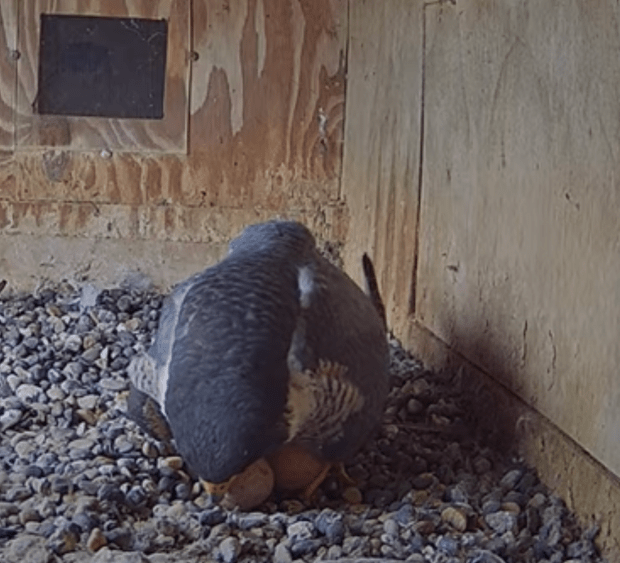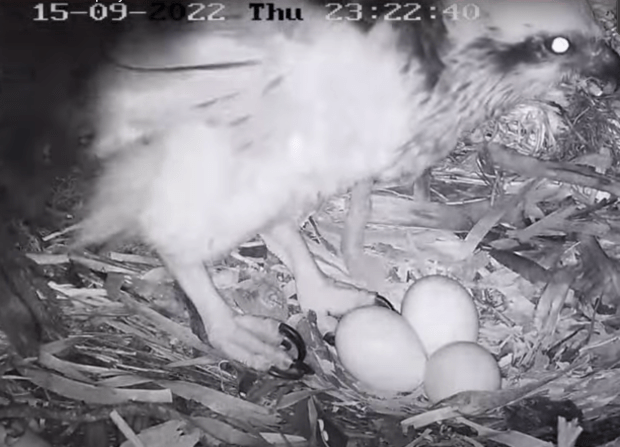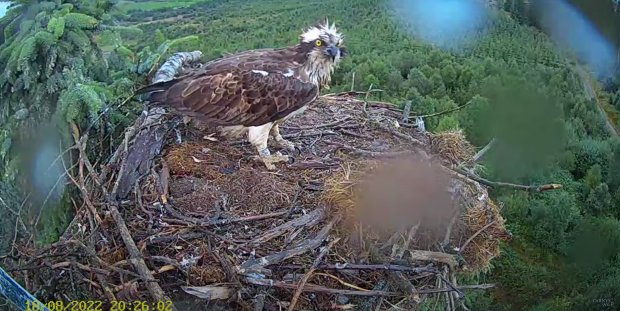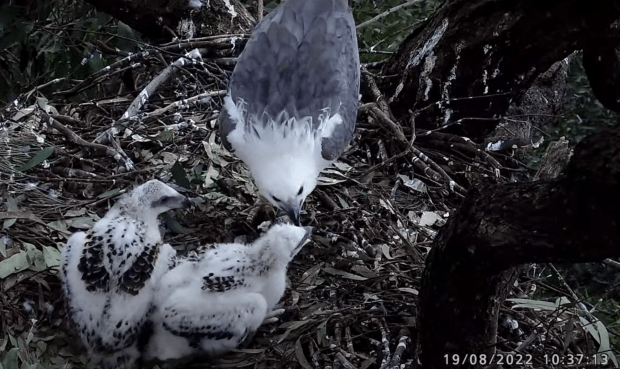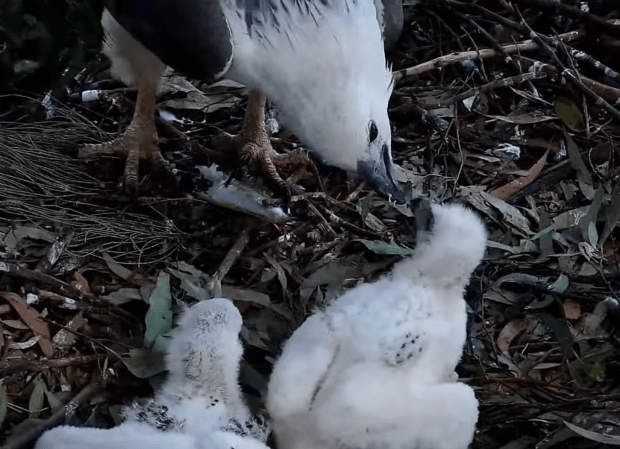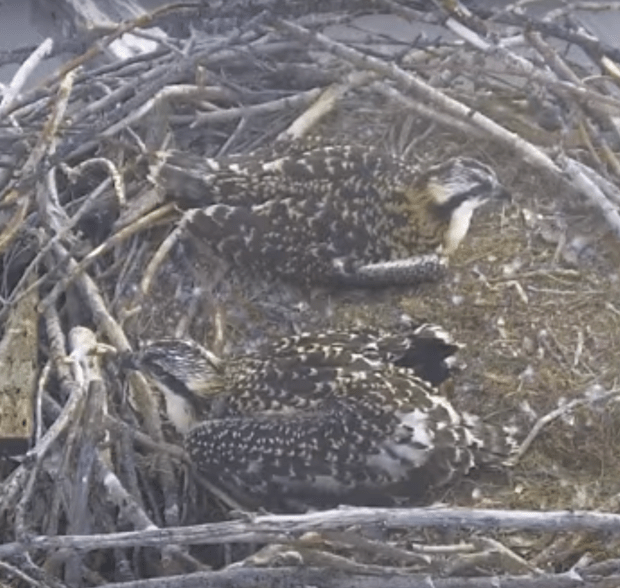11 June 2023
Good Morning Everyone,
On Saturday, I checked on Mini at Patchogue the first thing and then went off to count goslings and ducklings. I do not even know what to say. The numbers are dismal for hatches this year. Last year, we had floods that ruined the eggs. Some couples laid replacement clutches. But this year, there were simply not the number of geese in the parks to start and even fewer now. We know that the heat has driven all those without little ones north to find food and cooler weather. But what happened to their eggs in the first place? I am hoping that some of our goose specialists will have some answers later in the summer.
I have been following this goose couple all season. Like the other couple, below, they used the nesting baskets provided for their eggs. If there were predators about, this is why their eggs were safe. Why only one hatched for these two is not known. They have always had one little one tagging between them. They are very protective and with reason. This gosling is precious!



There was one other goose couple. They started out with nine youngsters and are now down to five. How adorable is this? A train in the water – Mum and Dad at either end keeping track so no one gets lost or left behind.


Looked and looked. Came across a pair of Hooded Mergansers and some turtles sunning themselves.

And a pair of Mallards with six ducklings.


At the nature centre, the geese and ducks generally remain in the confines of the wetlands, not venturing out as some of the others in our City might. There is a considerable absence of young this year. I then went to another site that I check regularly – where the Osprey flew over head the other evening. There were 38 Canada Geese and 16 goslings of varying ages.

The American White Pelicans were swimming around the edge of the pond and then decided to cross. They are lovely.

When I got home, it was a relief to see Junior enjoying the water in the bird bath and Scraggles on the fence eating a peanut. The garden is sooooo very quiet. (taken through window screens so not so clear)



Scraggles sees me and is frozen…he is living in a tree just down the lane. Wish I could find where Dyson is! The City cut down her original tree as it did Scraggles and she has relocated…

But, first up, there was an intervention at the Cornell Red-tail Hawk nest of Big Red and Arthur. Thanks to streaming cam watchers and volunteers, there was ‘movement’ noted in the ears of two of the Ms. Veterinarians from the Janet Swanson Wildlife Hospital observed and identified the problem as being maggots. They also noted that M3 was keeping its 3rd eyelid over its eye, indicating pain. Arrangements were made to intervene as leaving the infestations could cause pain, infection or damage to the ear and nerves. The intervention was successful and the Ms are now back in the nest with Big Red and Arthur. Thank you! Cause of the maggots: an abundance of prey!

Mini might get shut out of some meals, but, more often than not, Mini leaves with a big crop. On Saturday, there was a moment when the Third tried to intimidate Mini. It went away but was back at the table within a few minutes. Many of Saturday’s fish were very large. Everyone at the Patchogue Nest ate. One thing is for sure – Mini is growing! Those wings are getting bigger. Oh, I hope we are on the stretch to knowing that Mini will survive and fledge!
Mini waiting at noon for the next fish and it arrives. A nice big one.


Mini decides to sleep on the fish but is still in a bad spot for feeding.

Mini moves out of the way.

Oh, but Mini watches and waits and then just look at all that fish that is left and who is up there for a feeding.

After…a nice crop.

Just look at our Little Mini. Clown feet, the red copper feathers at the nape of the head. This osplet is changing and in the nest few days will look very different! Little Mini is going to have some nice feathers growing from that wooly charcoal coloured thermal down. Look carefully at the size of Little Mini’s wings. Not so ‘Little Mini’ anymore. Thankfully.

Throughout the day, Little Mini had a good crop. Dad always brings in at least one nice fish at the end of the day if not two. Mini was too full to eat! All is well.



It appears that Mini might have been shut out of all the early morning feeds at Patchogue. A fish has been left in the middle of the nest to encourage self-feeding and while Mini can sit at the open end and pull some flakes, he really is not yet able to hold it down and pull to get enough food. I am hopeful Mum will feed the little one. Big is now hoping and wing flapping.


‘H’ has been watching the Boathouse Osprey platform of Skiff and Dory closely for the first sign of a pip and it came Saturday morning! Day 39 for egg 1. ‘H’ reports that it was a quick hatch. Dory was not giving any secrets away but the first full view of the chick came at 1338. Thanks, ‘H’. Already wanting fish!


While there is jubilation at the Boathouse, there is growing concern at the Forsythe Nest that ‘H’ has been monitoring. Here are Saturday’s observations. “The aggression seems to be getting worse. There were 9 fish deliveries, but they were all small or small partials. Feeding 0750 to 0808 -Mini did not start out next to Little, and managed to get some bites, but when Middle slid back a little bit, Little attacked Mini. By 0757 Mini was back in a pretty good place [4,2,3,1]. Mini got some bites until Middle dropped back, and at 0806 Little again attacked Mini. Mini didn’t make it back. Total bites for Mini = 35. Feeding 0835 to 0900 – Mini started out eating beside Little and got many bites before Little even started to eat. Little already had a big crop. By 0840 Little wanted to eat, and beaked Mini (Mini never retaliates, simply goes into submission). At 0856 Mini was back at the table eating beside Middle. Big and Little had dropped out. Total bites for Mini = 45. Feeding 1030 to 1045 – Positioned [4,1,2,3]. Positioning stayed the same. There was no aggression. Total bites for Mini = 30.nFeeding 1158 to 1206. Positioned [1,4,3,2]. At 1159 Little beaked Mini, but shortly thereafter, Little dropped out. Mini soon came back and ate. Middle dropped out at 1204. Total bites for Mini = 29. Feeding 1603 to 1610 -Positioned [4,1,3,2], Mini should be good right? At 1606, Little lunged at Mini right across the front of Big, Mini dropped back. Then, Little beaked Big and Middle. Big attacked Little. Little then attacked Mini who was already in submission. Big attacked Little again. At 1607 Big and Middle ate. At 1609 Little tried to get back to eat, and was beaked by Big. Big wouldn’t allow Little to return. Then for some reason, Big beaked Middle. Mom, Opal, finished the fish. Total bites for Mini = 6. Feeding 1645 to 1654 – Positioned [3,4,1,2] Mini stayed tucked in submission from the start. So I went back to see what had transpired before the fish arrived. Well, for some reason at 1644 Mini beaked Big a couple of times. So Big punished Mini. Mini tucked and stayed tucked. They lined up to feed right around where Mini was. Little beaked big up at the food line, so Big beaked back and Little was out. So, Little had just a few bites, Middle and Big finished the fish. Bites for Mini – 0. Feeding 1735 to 1745 – Positioned [1,2,4,3} Mini had 2 bites and then was beaked by Little, then Big beaked Little. At 1736 Mini tried to stand up and was beaked by Big!!! So Mini stayed in the back. At 1743 Mom reached over and gave Mini one bite. At 1744 Little turned around and beaked Mini. Bites for Mini = 3. Feeding 1803 to 1812 – Mini tucked when the fish arrived. The other three ate. At 1805 Mini tried to approach the feeding line next to Little and is beaked. Ditto at 1807 and 1810. Bites for Mini = 0. Feeding 1855 – 1908 – Mini tucked when the fish arrived. But Mini did approach the line, positioned [1,2,3,4}, got one bite of fish then was beaked by Little. At 1857 and 1859 Mini tried to approach and was beaked by Little. At 1903 Mom reached out and gave Mini 4 quick bites, but as soon as Little realized it, she beaked Mini. Total bites for Mini = 5.


Sunday morning saw improvements for Mini at Forsythe. ‘H’ reports: “Feeding 0539 to 0606 – Huge live fish,From the start, Little beaked Mini pretty badly, Mini out. Ditto at 0545, 0546, 0552 0604. At 0553 Big beaked Little. Each time Mini tried to engage, s/he was beaked by Little. Now, I was encouraged by the size of this fish, because the large fish tend to increase Mini’s chances of getting a private feeding at the end. Well, inexplicably, with 75% of the fish remaining, Oscar took it off the nest!! Cringe. Really Dad? Bites for Mini = 0. Feeding 0650 to 0716 – Oscar had taken the previous fish to the perch to eat, and he brought back 1/2 of the large fish. Mini got bites early, Little was late to the table, but by 0652 Little beaked Mini. Again 0655 Little attacked Mini when Mini raised up; that time Big beaked Little very aggressively and Little was out. Big laid down beside Little, between Little and the feed line, so Little couldn’t get back! One time Little tried, and Big raised up and gave her ‘the look.’ So, Middle and Mini ate. By 0706 Middle dropped out. At 070648 Mini walked away with a large crop, but Mini returned at 070830; and walked away again at 071030; and Mini returned to feed at 071315. Both Middle and Big returned for a few bites later on, but Little never did make it back to the front. Total bites for Mini = 102 YES!!!

‘H’ reports that the Dahlgren cam was down all day. She notes reports of two good feedings at Severna. Her observations of both nests at Patuxent revealed that all is well.
Kathryn reports on the Carova Osprey nest. She observes, “The dad has delivered 8 fish so far today. And it is only 3:30pm! They are averaging one fish per hour. It seems like the chicks are rotating feedings and one usually naps while the other two eat and then the one eats at the next feeding. Here they are all amazed because the dad brought two fish at once and one was flopping around! A commenter suggested this may have been done purposely by the dad to get them used to an alive fish! So cool.”

The fish are not always plentiful at the Cowlitz PUD nest. Most days, they might be said to be ‘pitiful’ compared to the size and number being brought to Patchogue. One nice sized fish did get on the nest on Saturday after Kathryn observed only a couple of tiny ones and the Only Bob got a feed.

The wee one had a nice crop and Electra had a good meal, too.

Imagine raising these little osplets from eggs found in a chimney. Sunnie Day posts a heartwarming story from MSN.COM:

Syndication: Cape Cod Times
ORLEANS 06/10/23 Wild Care’s Stephanie Ellis feeds just days old hungry osprey chicks their breakfast of ground quail She raised the birds from eggs that were removed from nests built on chimneys in Osterville and Falmouth by wild life officials The mission next, get the chicks placed into surrogate nests soon along with chicks their same age to be raised by a new set of parents Cape Cod Times/Steve Heasli in ORLEANS 06/10/23 Wild Care’s Stephanie Ellis feeds just days old hungry osprey chicks their breakfast of ground quail. She raised the birds from eggs that were removed from nests built on chimneys in Osterville and Falmouth by wild life officials. The mission next on ORLEANS 06/10/23 Wild Care’s Stephanie Ellis feeds just days old hungry osprey chicks their breakfast of ground quail. She raised the birds from eggs that were removed from nests built on chimneys in Osterville and Falmouth by wild life officials. The mission next, get the chicks placed into surrogate nests soon along with chicks their same age to be raised by a new set of parents. Cape Cod Times/Steve Heasli.
‘A’ has been pondering the nest of Angel and Tom and the upcoming fledge of Deyani.

“Can I nominate Angel as mother of the year? She only raised one, I know, but the sheer horror of watching her mate kill their first-born shook her to the core, and her ability to raise the second hatchling as she did, smothering it with love and protection, hunting for it alongside Tom to make sure it was properly fed until he got his act together, putting up with constant bombardments from the blue jays and their extended family, literally bouncing off her at the rate of up to a dozen hits per minute, was nothing short of inspirational. Even when Deyani was nearly as big as mum, Angel was on the nest during rain, sheltering her baby to the best of her considerable ability (she is a fantastic mumbrella, with those warm and cosy underfluffies looking very safe and appealing), spreading her wings to cover a huge area. She has been absolutely devoted.” “Meanwhile, it just occurred to me that rarely has a chick been so lucky to be born second on a nest. (Yes, I know, it’s a bizarre thought, but true.) I do miss that first hawklet, even though we only knew the little one for a day. It was such a sweet little cutie, and I will never forget its adorable face as it looked up at its dad and yawned. It was our final view of the chick alive. At least its death was quick – hawks are obviously relatively efficient in that regard. But I think a lot about what Deyani has missed out in without her sibling and Angel’s grief was truly something awful to watch. She was heartbroken. And very very angry. She knew she still needed Tom but she didn’t have to like that fact! I hope she has forgiven him for his error – he has done his best to do his best, as it were, and as I mentioned, he even fed Deyani the other day (or, rather, Deyani took food from his beak in a manner reminiscent of feeding). I hope they stay together now and build on what they have done this season. It is such a lovely, peaceful, prey-rich area to raise chicks.”
I did not, as mentioned earlier, check on many nests on Saturday. I am so grateful to those who monitor Osprey nests for me and those who send me news of nests I have been monitoring for one reason or another but did not on Saturday. ‘SP’ sends me new screen captures of the eyas from the Evergy Topeka Peregrine Falcon scrape. Oh, goodness. The wee one looks much better now that those feathers are breaking out of those quills. Now this really is a relief.


Dmitri’s storklet is certainly growing and eating – thriving under the care of this generous and compassionate man.

Dmitri has his storklet outside on the ground in this short video.
Ervie looking good! I kept the comment so you could see it is Ervie. Hard to locate that tracker the way he is situated.

Don’t these Osprey Mums know that we want to see that every chick gets fed?! Barnegat Light 1815 Saturday.

On Sunday, ‘H’ was able to get sight of some feedings, “Feeding from 0644 – 065230. Little was in the back, kind of clueless as to how best to get fed. After several minutes Little started to move around Big and got two bites from Daisy. But, clumsy Big inadvertently knocked Little into the back row again. It was a long time until Little finally got beside Big and began to consistently get bites. Soon Big and Middle dropped out. They are clumsy and awkward, but, there was no intentional bonking between any of them. Total bites for Little = 17.


Crossing the Pond and look at those healthy chicks of Idris and Telyn at the Dyfi Osprey nest in Wales.


What a beautiful Osprey family – CJ7 and Blue 022 – and their trio at Poole Harbour.



Lady
Laddie has had to spend too much time guarding the territory and needs more time being able to fish for the family. There were no less than six intruders seen. Laddie delivered a fish in the morning and one around 1330. Blue NC0 was fish crying for her and the kids Sunday morning.

At Loch Arkaig, we have the ‘bobbing’ Bob. The Only Bob seems to like to beak Dorcha’s talons. It reminds me of a nicknack my grandmother’s had – a bird that would bob its head and pick up a toothpick. The Only Bob is 11 days old today, and you can see it is entering the Reptile phase. See that oily black head. Louis delivered at least five fish on Friday and is known for being diligent…the chick is definitely not hungry!

It is also time to begin checking on Dad and Lady at the WBSE nest in the Sydney Olympic Park. It is now time that eggs could be laid! ‘A’ is going to keep tabs on this couple for us. She reports, “Shortly after 2pm, both Lady and Dad were back on the nest in Olympic Park. Dad arrives first, around 14:02, and arranges a stick before just standing in the middle of the nest for a couple of minutes, looking around as if surveying the area. Checking it for potential threats perhaps? Lady joins him just before 14:07. Dad does some aerating in the centre of the nest as Lady watches. They then stand in the middle of the nest for a moment. Their visits to the nest are becoming increasingly frequent. These two are definitely trying for an egg (or two). Lady is not only ‘receptive’ but appears to be actively encouraging mating, which would lead one to presume her ‘window of hormonal opportunity’ is open.”


I know that many of you are interested in bird feeders and their cameras and this particular video caught my eye. There is a Cooper’s Hawk that visits!
Thank you for being with me today in Bird world. Take care everyone. See you soon!
Thank you to the following for their notes, videos, posts, and streaming cams that helped to create my blog today: ‘A’, ‘H’, Kathryn, ‘SP’, Cornell RTH Cam, PSEG, Audubon/Explore, Forstythe Ospreys, Outerbanks 247, Cowlitz PUD, Sunnie Day and MSN.com, Window to Wildlife, Evergy Topeka, Storks on line, Janice Love and Friends of Osprey Sth Ads, Barnegat Light and Conservation Conservancy of NJ, Dyfi Osprey Project, Poole Harbour ospreys, LOTL, Friends of Lock Arkaig and the Woodland Trust, Sydney Sea Eagle Cam, and Gettysburg Live Cam.
























